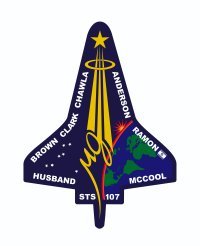Thu, Jan 30, 2003
STS-107 Report #14; Tuesday, January 28, 2003 -- 5 p.m.
CST
 The Red team of astronauts aboard the Space
Shuttle Columbia accomplished repairs on the third and
final combustion experiment of STS-107 this afternoon, and support
scientists on the ground were looking forward to working with the
Blue team on the first scientific runs.
The Red team of astronauts aboard the Space
Shuttle Columbia accomplished repairs on the third and
final combustion experiment of STS-107 this afternoon, and support
scientists on the ground were looking forward to working with the
Blue team on the first scientific runs.
Mission Specialist Kalpana Chawla reported a good leak check of
the Combustion Module-2 Facility about 4 p.m. after five hours of
work. She and Commander Rick Husband sent down video of the
recovery procedures for the Water Mist Fire Suppression Experiment
(MIST) around 2 p.m. to give engineers on the ground an opportunity
to visually inspect the equipment. The combustion facility, which
provides control, containment, diagnostics and communications for
fire-related experiments, worked flawlessly in support of the two
previous combustion experiments, but failed its initial leak checks
when MIST was installed Monday.
Payload Commander Michael Anderson of the Blue team is scheduled
to begin work with the MIST experiment overnight. Designed by
the Center for Commercial Applications of Combustion in Space at
the Colorado School of Mines, Golden, Colo., the experiment will
investigate how water mist inhibits the spread of flames.
Scientists hope to apply what they learn to designs for improved,
lighter-weight fire suppression systems on Earth, as well as for
spacecraft-based systems that won’t require ozone-damaging
chemicals such as Halons.
 Husband, Chawla and Red team colleagues Lauren
Clark and Ilan Ramon enjoyed some time off for the first half of
their day, then moved ahead with other experiments in the Spacehab
Research Double Module. Clark retrieved samples associated with the
Bioreactor Demonstration System, which Project Scientist Tom
Goodwin reported today has grown a bone and prostate cancer tumor
tissue sample as large as a golf ball, the largest grown in space
to date. She also collected blood and urine samples from her
crewmates for the Physiology and Biochemistry (PhAB4) suite of
experiments. Ramon also conducted observations of dust off the
African coast for the Mediterranean Israeli Dust Experiment
(MEIDEX).
Husband, Chawla and Red team colleagues Lauren
Clark and Ilan Ramon enjoyed some time off for the first half of
their day, then moved ahead with other experiments in the Spacehab
Research Double Module. Clark retrieved samples associated with the
Bioreactor Demonstration System, which Project Scientist Tom
Goodwin reported today has grown a bone and prostate cancer tumor
tissue sample as large as a golf ball, the largest grown in space
to date. She also collected blood and urine samples from her
crewmates for the Physiology and Biochemistry (PhAB4) suite of
experiments. Ramon also conducted observations of dust off the
African coast for the Mediterranean Israeli Dust Experiment
(MEIDEX).
More News
He Attempted To Restart The Engine Three Times. On The Third Restart Attempt, He Noticed That Flames Were Coming Out From The Right Wing Near The Fuel Cap Analysis: The pilot repor>[...]
Make Sure You NEVER Miss A New Story From Aero-News Network Do you ever feel like you never see posts from a certain person or page on Facebook or Instagram? Here’s how you c>[...]
From 2009 (YouTube Edition): Leading Air Show Performers Give Their Best Advice for Newcomers On December 6th through December 9th, the Paris Las Vegas Hotel hosted over 1,500 air >[...]
Aero Linx: NASA ASRS ASRS captures confidential reports, analyzes the resulting aviation safety data, and disseminates vital information to the aviation community. The ASRS is an i>[...]
“For our inaugural Pylon Racing Seminar in Roswell, we were thrilled to certify 60 pilots across our six closed-course pylon race classes. Not only did this year’s PRS >[...]
 NTSB Final Report: Rutan Long-EZ
NTSB Final Report: Rutan Long-EZ ANN FAQ: Turn On Post Notifications
ANN FAQ: Turn On Post Notifications Classic Aero-TV: ICAS Perspectives - Advice for New Air Show Performers
Classic Aero-TV: ICAS Perspectives - Advice for New Air Show Performers ANN's Daily Aero-Linx (06.28.25)
ANN's Daily Aero-Linx (06.28.25) Aero-News: Quote of the Day (06.28.25)
Aero-News: Quote of the Day (06.28.25)




